Ultimate Primer for Feng Shui
Introduction
Feng shui has been gaining popularity in the West.
Interest in east Asian cultures has been on the rise.
The mystical or superstitious nature of the practice piques people’s interest even more.
The widespread appeal is due to its simple logic.
Although feng shui is based on the Chinese view of the whole universe the concepts are universal.
There is also this notion that more people nowadays are unhappy with their lives due to their fading careers or failing personal relationships.
That motivates people to learn unconventional practices like feng shui as part of self-help.
Feng Shui is Wind and Water
Feng shui (风 水) is a combo of two characters- wind (风) and water (水).
Why call it wind and water?
Well, wind and water are part of the earth’s topography.
Think about the wind flowing through the hills, valleys, and mountains.
Imagine a picturesque natural scene of water flowing through our rivers, streams, and mountains.

Wind and water continuously interact with one another and help shape the geography around us.
These two natural elements continuously interact with each other and shape varied sizes and orientations of our geography.
In feng shui, the quality of our daily life indirectly depends on how we as human beings interact with these natural forces of our surroundings.
Good and Poor Feng Shui
Good feng shui is when wind and water around your home and office are harmonious and well-balanced.
Poor feng shui is the opposite of good feng shui; wind and water are not harmonious with your living and working environment.
When feng shui is poor, it brings illness, misfortunes, or even disasters.
Feng Shui Is From China
Imagine yourself living in China many thousand years ago as a peasant farmer.
You’d likely live in a bucolic, rustic countryside.
The daily struggle to survive was a norm in agrarian life.
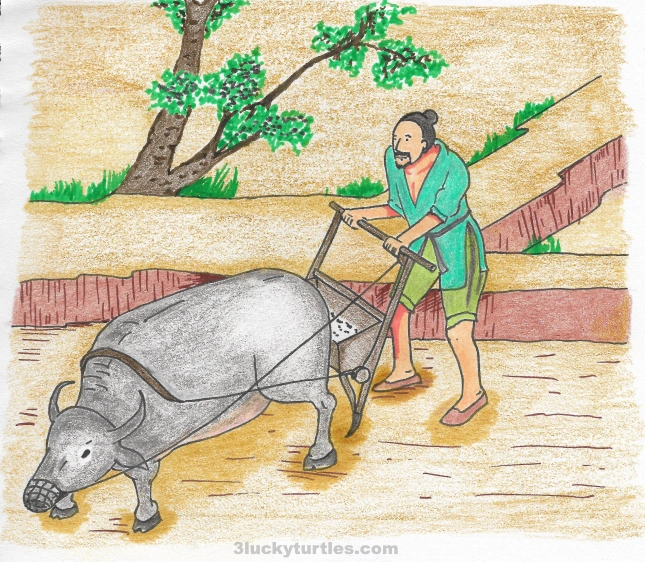
Peasant farmers figured out how to prosper by understanding the forces of nature, and eventually, feng shui was born.
Until you and other peasants figured out how to prosper by understanding the changes and forces of nature.
In other words, feng shui was and still is the study of how we are affected by the environment and how we can manipulate our surroundings to enhance our lives and fortunes.
Feng Shui is Not Japanese
However, the knowledge of feng shui spread to Japan from China during the Heian period.
This knowledge has evolved into its unique Japanese form today.
Japanese called this Kaso (家 相).
Like feng shui, Kaso helps ascertain the auspiciousness of a piece of land and the layout of a house.
Japanese also uses a type of geomantic compass design that is slightly different from the conventional one the Chinese use.
A Chinese compass has an even octagonal division for each direction.
But a Japanese geomantic compass has each main direction- east, west, north, and south with a section size of 30 degrees.
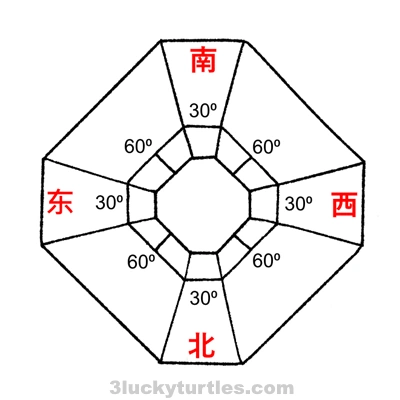
A Japanese geomatic compass does not have an equal division of an octagon.
East-south, west-south, west-north, and northeast sections of the compass have an angle of 60 degrees.
Qì (氣) is an Integral of Feng Shui
In ancient times, the Chinese found something flowing in the human body.
They called this qì (sometimes spelled as chi).
Qì is a form of vital energy, energy force, or simply energy.
Now close your eyes.
Think of qì as something intangible, shapeless, and formless.
Qì is not just a feng shui thing.
Traditional Chinese practices such as acupuncture, medicines, and even martial art such as Tai Chi talks about qì.
Qì is Energy
Let us look at how to write qì in traditional Chinese form.
Notice that little character 米 that is called mi. It means rice in Chinese.
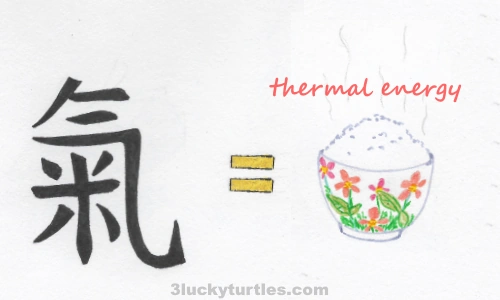
Chinese character Qì (氣) is represented by a piping hot bowl of rice.
Now here’s the fascinating part about Chinese writing.
Combining two or more characters create a new meaning.
In this case, combining 气 and 米 creates the character qì (氣).
氣 illustrates the steamy energy from the rice when it is being cooked.
And that is precisely what qì is all about- energy!
Qì is a form of energy force that flows through our body by following paths called meridians.
When someone practices Tai Chi, the meridians are opened.
This makes qì flows better in the body and consequently increases the energy level of that person.
Consequently, a person becomes more energetic and healthier.
Note: The character chi in Tai Chi (太 极) does not carry the same meaning as the character qì (气) explained here represents energy.
In the video above, world-renowned Tai Chi master Chris Pei explained the concept of qì when practicing Tai Chi.
Even though the qì explained here is related to Tai Chi, it is the same qì in feng shui.
Qì is in Our Universe
In feng shui, there is a belief that all things in the universe possess qì.
Using this concept, qì similarly exists in other entities such as plants, buildings, mountains, rivers, and more.
Qì is constantly flowing in and out amongst these entities.

The house’s main door is crucial in feng shui as it is considered the “mouth” of qì.
Our qì energy is also constantly mixing with other qì energy around us.
In external environments, the quality of qì is influenced by the nature of hills, valleys, and rivers.
In our home, the qì quality depends on the orientation of items like furniture present in each room and how these items are arranged one another.
There are also imposing structures in your external environments that emit negative energy that you must be aware of.
The qì energy you soak up from the environment around you influences your emotions, moods, physical energy, and health.

An imposing structure near your house like a pylon is emitting negative energy or shā qì and is considered poor feng shui.
So how does the qì energy flow in our environment? Remember wind and water?
The qì energy is transferred within the environment by wind, water, sound, and energy from our sun.
It can also flow in and out of buildings via doors and windows. Qì energy can equally enter and leave through building walls.
Also, the placement of entrances, exits, doors, and windows in a building like our home will affect the quality of qì.
Main doors are exceptionally very crucial in the practice of feng shui.
Wuxing is Inseparable from Feng Shui
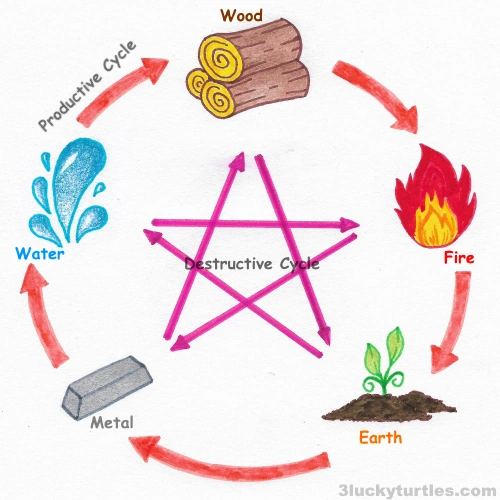
Wuxing (五 行) or the “5 Elements” in Productive and Destructive Cycles.
Another core concept of feng shui practice is the theory of 5 elements that have to do with 5 directions related to the sun’s movement.
Think of this when the sun rises in the east in the morning, then your home absorbs the upward qì known as wood energy or sometimes called tree energy.
As the day goes on, the sun moves from east to south, and your home then radiates with fire energy.
After that, the sun starts to set and brings more earth energy into the center of your home.
As the sun sets, the west of your home absorbs metal qì energy. At nighttime, the north of your home receives the flow of water qì energy.
According to feng shui teaching, each element is a by-product of the previous element.
For example, in a productive cycle of the elements, fire produces earth, then creates metal, which makes water, then creates wood which then makes fire.
In a destructive cycle, the sequence of all 5 elements changes to the following order: wood, earth, water, and fire followed by metal.
Each of the 5 elements can be represented by color, season, number, animals, and objects around us.
Wood
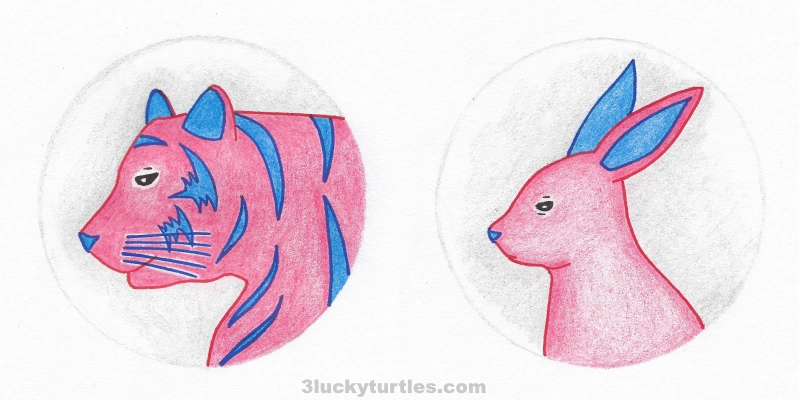
Tiger and rabbit represent the Wood element.
represents all shades of green
spring season
symbols of wood elements include plants, furniture, and all stuff that are made from wood
represented by numbers 3 and 4
Tigers and rabbits are wood animals
Fire
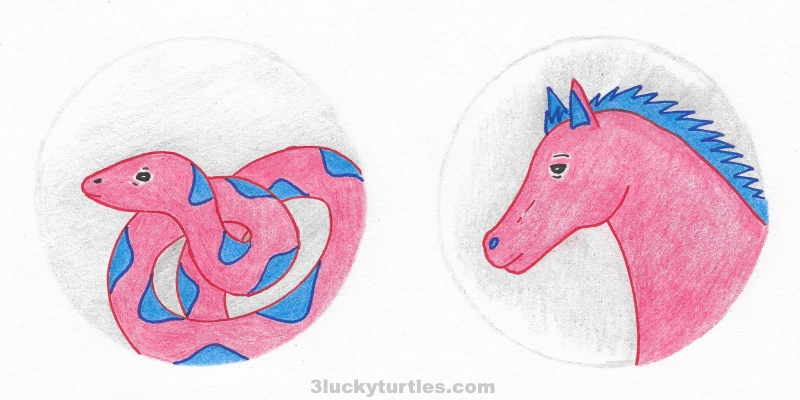
Snakes and horses are Fire animals.
represents the red color, and in Chinese, it is considered a very auspicious color
summer season
symbol of this element is a bright light
Represented by 9
snake and horses are fire animals
Water
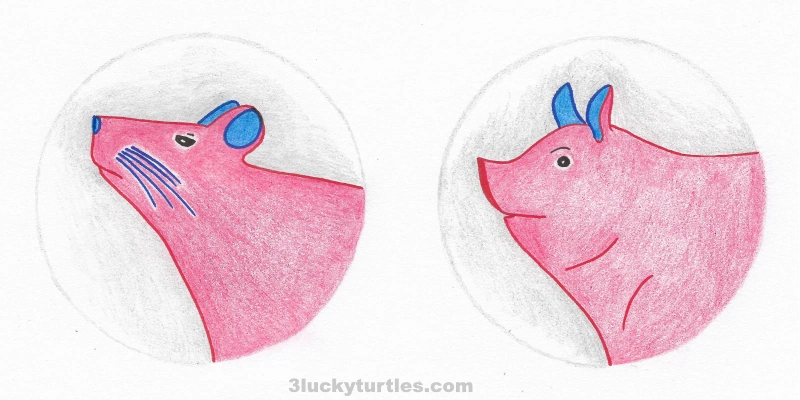
Rat and pig belong to the Water element.
Represents the black or blue color
A yin element
objects of water include fountains, fish aquariums
Rat and pig belong to the water element
Number 1
Metal
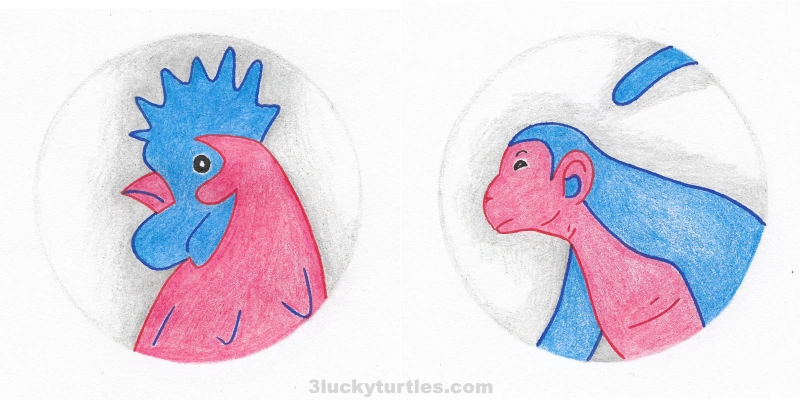
The rooster and monkey belong to the Metal element.
Metallic colors such as gold, silver, or white
Objects of the metal element include coins, wind chimes, bells, jewelry
6 and 7
Rooster and monkey belong to the metal element
Earth
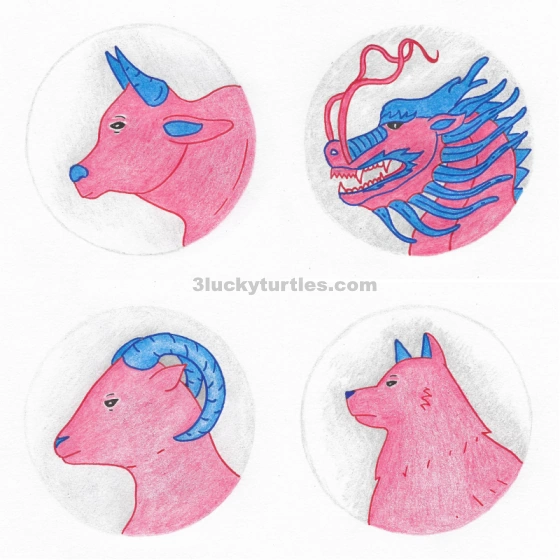
Ox, dragon, goat, and dog are Earth animals.
represents all shades of brown
Early autumn
Earth element numbers are 2, 5, and 8
Ox, dragon, goat, and dog belong to the earth element
Yin-Yang Balance is Paramount in Feng Shui
Feng shui’s fundamental teaching is really about balance.
There were two opposite elements or forces that complement each other in Chinese culture.
We call this Yin and Yang.
A symbol known as Tai Jitu (太 极 图) diagram represents these complementary forces.
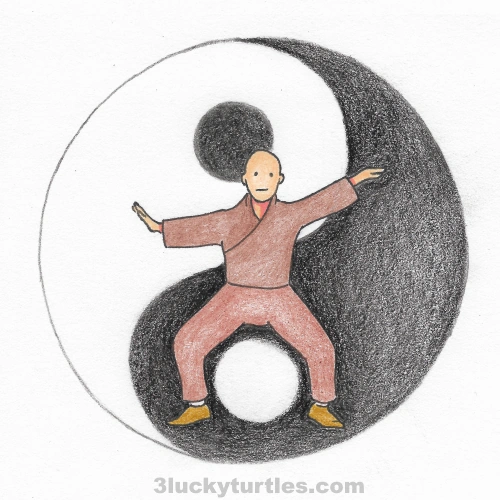
Tai Jitu symbol represents the complementary forces of yin and yang in Chinese culture.
For example, a female is a yin, while a male is a yang.
Similarly, darkness is a yin, and brightness is a yang.
The first half of the symbol represents yang in white (the black circle in the middle represents yin).
The other black half represents yin (the white circle in the middle represents yang).
The diagram represents the concept that if the yin element becomes extreme, it turns into yang.
As the yang becomes substantial, it turns into yin. Since there are a small black circle and white circle in each yin and yang, we can see that there is yang in yin and yin in the yang.
Moderation is about maintaining a balance and not bias toward one or the other side.
Therefore, we should not interpret yin as bad, or yang as good.
Yin and Yang in Feng Shui
A balance between yin and yang represents the wholeness of the universe.
Therefore, in feng shui practice, yin-yang analysis is always done on room space, sunlight, shade, dampness and dryness, solids, and fluids.
For example, if a room is too yin or dark, it is thus not auspicious, and consequently, there are insufficient life energies to bring prosperity.
On the other hand, a room that is too yang is considered harmful due to too much presence of energy which will lead to accidents and financial loss.
Only rooms or homes with balanced yin and yang can be auspicious.
Feng Shui is Influenced by Buddhism and Taoism
Feng shui has both philosophical and religious roots.
As feng shui is indigenous to China, it was also influenced by Buddhism too.
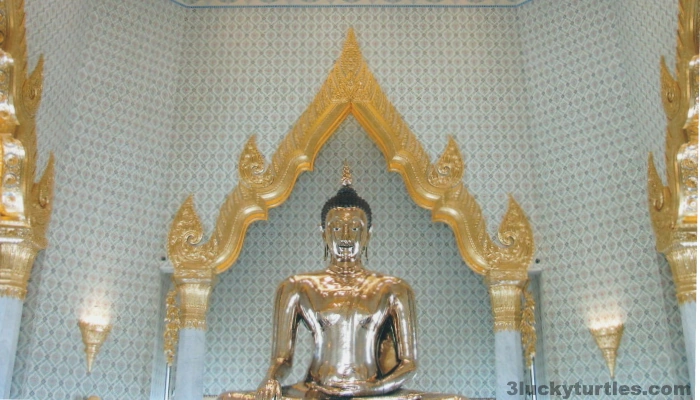
Feng shui drew some influences from Buddhism.
Feng shui combines Taoism, Chinese folk cures, early science, and common sense.
Then you have Buddhism added to the diverse mixture.
Chinese Buddhism is a product of its long journey from India through Tibet and then into China.
Each country adopted Buddhism differently.
In India, Buddhism is replete with meditations, yoga, chants, concepts of dharma, and compassion.
Buddhism in Tibet incorporated native mystical charms and chants of the Bon tradition.
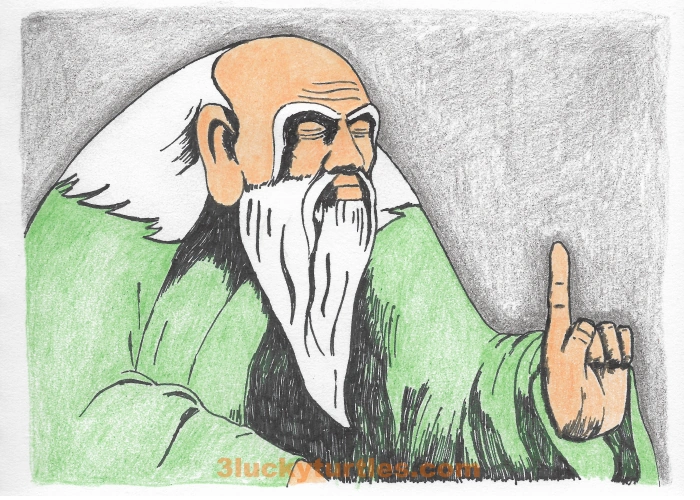
Laozi, the founder, and philosopher of Taoism.
And in China, Buddhism adopted indigenous thought and practices: the I Ching, Taoism, Confucian, folk religions, and feng shui.
The outcome is a union of complementary opposites, a practical and intuitive approach to the environment that offers an array of useful and mystical cures.
Wrapping Up
Recapping this piece, feng shui consists of a few essential components- yin and yang, Wuxing, and understanding the flow of qì.
It was born thousand years ago in China and encompasses ancient Chinese wisdom and some reverence for supernatural, and cultural beliefs.
The main objective of feng shui is to guide you to position yourself in such a way that the natural flow of qì helps you to achieve your personal goals and dreams in life.
